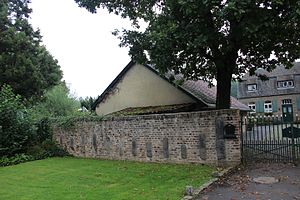Schönwaldhaus
The Schönwaldhaus (also: Schönewaldshaus or Schönewaldhaus ) is a forest service building in the Röttgen district of Bonn . The three-part courtyard ensemble has the address Villiper Allee or Dorfstraße . Immediately on Kottenforst and on the municipal boundary of Villiprott ( Wachtberg located), it stands along with several historical landmarks under monument protection .
history
In 1730/31 the Cologne elector Clemens August von Bayern had a court ensemble built as a forest service building for the forester and riding electoral hunter Johann Heinrich Schönewald (approx. 1687–1772). It served the administration of the Kottenforst as an electoral parforce hunting area . Schönewald had been working as a forester in the electoral forestry on the Philippine Röttgen , which existed here since around 1600, since the mid-1720s . In 1893 the living quarters and the gatehouse opposite were demolished; a new, single-storey house was built, which was enlarged by one floor in a mansard roof in 1908 . In 1971, an enclosure wall with a passage was built between the buildings. At first, the forester's house was referred to as the “Schönewaldshaus”, according to a map by Jean Joseph Tranchot . Later the name was shortened to the “Schönwaldhaus” which is in use today.
Until the 20th century the forestry had over 32 acres of agricultural land. Cows and horses were kept. At the beginning of the 19th century the homestead was given the address "Villip No. 118". Until 1834, three generations of the Schönewald family (Johann Heinrich, Johannes and Johann Wilhelm Schönewald) worked as foresters in the Schönewaldhaus. In 1899 the forester of the forester's house was granted the concession to sell non-alcoholic refreshments to walkers. The sale took place until 1937 and was the reason for the local name of the hiking trail from Ippendorf to the forest building as the “coffee path”. The building is still used today as the home of the responsible district forester. There is a parking lot for hikers opposite the forestry department.
architecture
The court ensemble was originally built as a Franconian square courtyard. With the demolition of the gatehouse without replacement, in which the servants' chambers were housed, a farmstead now open to the street was created. The still existing, low cattle shed was provided with massive walls and loopholes to the northwest on the forest side. The opposite, high half-timbered barn with a hipped roof from the building of the Electorate of Cologne still exists. When it was rebuilt in 1893, the house was designed in the style of the Prussian forest houses at the turn of the century . Boundary stones (so-called landmarks) from the 17th to 19th centuries were set into the surrounding wall to the left and right of the Kottenforster passage. The house has a central entrance with two window axes on the left and right. There are three attic windows on each side of the half-hip roof.
See also
Web links
Individual evidence
- ↑ List of monuments of the city of Bonn (as of March 15, 2019), p. 35, number A 643
- ↑ Allgemeine Forstzeitschrift , Volume 30, Bayerischer Landwirtschaftsverlag, 1975, p. 155 (Snippet)
- ↑ a b c d Entry by Jan Peter Schnadt on Forsthaus Schönwaldhaus in Kottenforst in the database " KuLaDig " of the Rhineland Regional Association , accessed on August 11, 2017.
- ^ Website of the Rhineland Nature Park , Zweckverband Naturpark Rheinland
- ^ A b Heinz Schönewald, Family Schönewald , Schönewald Publications
- ↑ On the “coffee path”: To the hunter's house in the Kottenforst. Koeln.de, accessed on August 11, 2017 .
- ↑ Bernhard Berzheim, Ippendorf: from poor farming village to preferred Bonn residence , Bonner Heimat- und Geschichtsverein , Der Verein, 1990, p. 333 (Snippet)
- ^ Frank Günter Zehnder (ed.): A society between tradition and change: Everyday life and environment in the Rhineland of the 18th century (= Dumont art travel guide . Volume 3 ). Dumont literature a. Art, Cologne 1999, ISBN 978-3-7701-5005-2 , p. 199 .
Coordinates: 50 ° 38 ′ 47.2 " N , 7 ° 4 ′ 58.2" E


